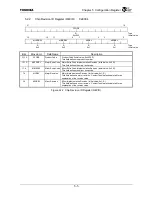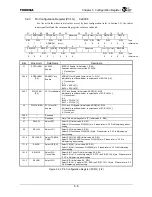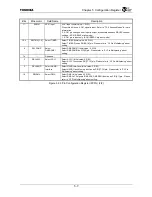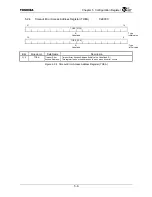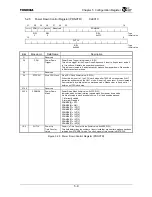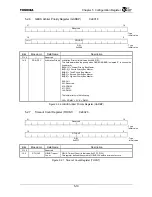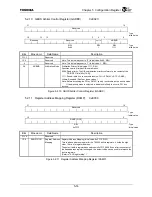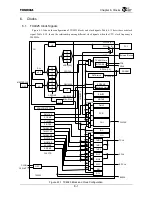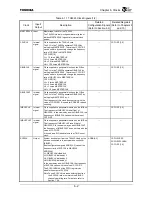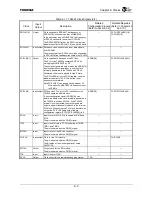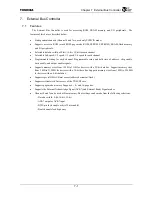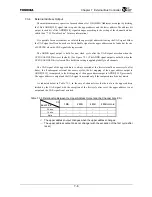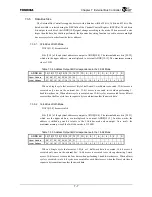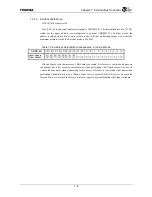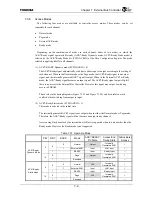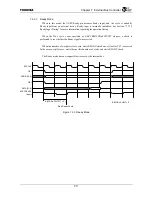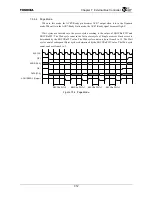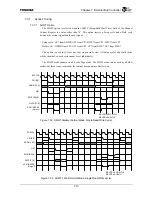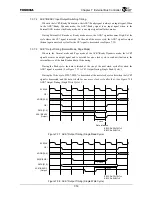
Chapter 6 Clocks
6-5
6.2 Power-Down
Mode
6.2.1
Halt Mode and Doze Mode
The WAIT instruction causes the TX49/H2 core to enter either of the two low-power modes: Halt and
Doze. The TX49/H2 can exit from Halt or Doze mode upon an interrupt exception. Ensure, therefore,
that the TX49/H2 does not enter Halt or Doze mode when all interrupts are masked in the interrupt
controller.
The HALT bit of the TX49/H2 core Config register is used to select Halt or Doze mode. As the
TX4925 does not use the snoop function of the TX49/H2 core, the bit should be set to select Halt mode,
which achieves greater power reduction than Doze mode.
Setting PDNCTR.STPCPU to 1 and then executing the WAIT instruction can stop the clock input to
the TX49/H2 core, thus further reducing power dissipation.
The PDNCTR.STPCPU bit is not automatically cleared to 0 when the device exits from Halt or Doze
mode. To subsequently reenter Halt or Doze mode, first clear the bit to 0 in the program.
6.2.2
Power Reduction for Peripheral Modules
When the system does not use the DMA controller, PCI controller, CHI module, serial I/O controller,
timers/counters, SPI module, parallel I/O controller, or AC-link controller, it can stop the input clock for
that module to reduce power dissipation.
The clock control register (CLKCTR) is used to control whether to turn each clock on or off. The
module should be reset before its clock can be turned on or off. This reset is performed using the reset
bit for the specific module, provided in the clock control register. The reset also initializes the registers
of the module, thus requiring subsequent setup of necessary register values and other configurations.
Refer to Section 5.2.9, “Clock Control Register” for detail of the clock control register (CLKCTR).
6.2.3 Power-Down
Mode
Setting the PDNCTR.PDN bit to 1 can stop all clocks output from the CG. This also stops the PLL. In
this state, only the RTC operates with the 32 kHz clock.
There is some delay between the time when the PDNCTR.PDN bit is set to 1 and the time when the
PLL and clock outputs actually stop. To prevent a bus cycle from occurring during power-down or
power-up transition, execute the program from cache.
Use an external interrupt or RTC interrupt to exit from power-down mode. PDNCTR.PDNMSK
specifies which interrupt will be used. Note that if the device enters power-down mode with all
interrupts disabled, you can only restore device operation by resetting it.
The PDNCTR.PDN bit is not automatically cleared to 0 when the device exits from power-down
mode. To subsequently reenter power-down mode, first clear the bit to 0 in the program.
Summary of Contents for TMPR4925
Page 1: ...64 Bit TX System RISC TX49 Family TMPR4925 Rev 3 0 ...
Page 4: ......
Page 15: ...Handling Precautions ...
Page 16: ......
Page 18: ...1 Using Toshiba Semiconductors Safely 1 2 ...
Page 40: ...3 General Safety Precautions and Usage Considerations 3 18 ...
Page 42: ...4 Precautions and Usage Considerations 4 2 ...
Page 43: ...TMPR4925 ...
Page 44: ......
Page 54: ...Chapter 1 Features 1 8 ...
Page 58: ...Chapter 2 Block Diagram 2 4 ...
Page 88: ...Chapter 4 Address Mapping 4 12 ...
Page 226: ...Chapter 8 DMA Controller 8 58 ...
Page 260: ...Chapter 9 SDRAM Controller 9 34 ...
Page 480: ...Chapter 15 Interrupt Controller 15 32 ...
Page 554: ...Chapter 19 Real Time Clock RTC 19 8 ...
Page 555: ...Chapter 20 Removed 20 1 20 Removed ...
Page 556: ...Chapter 20 Removed 20 2 ...
Page 564: ...Chapter 21 Extended EJTAG Interface 21 8 ...
Page 580: ...Chapter 22 Electrical Characteristics 22 16 ...
Page 588: ...Chapter 24 Usage Notes 24 2 ...

